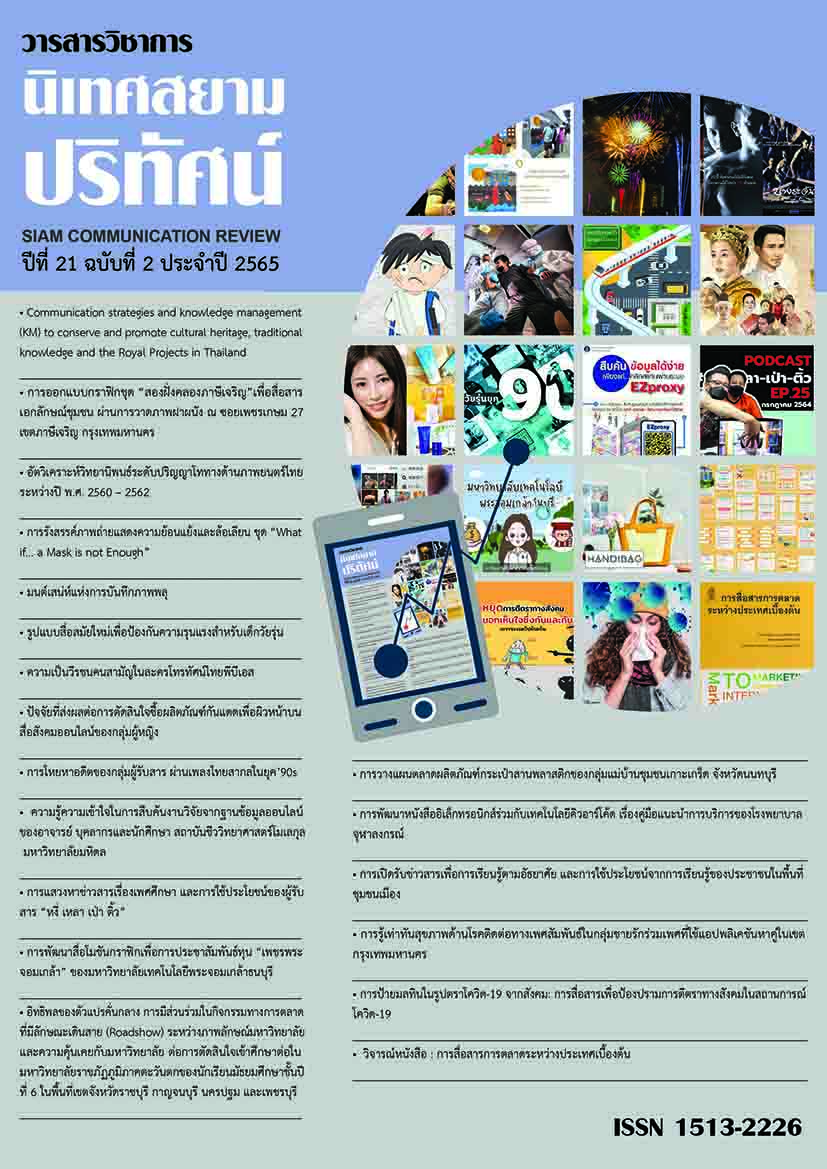Information Seeking and Information Utilization of the “Ngee Lhao Pao Tiw” Program Audience
Main Article Content
Abstract
This research is an exploratory research which aims to study 1) the information seeking of the audience of the “Ngee Lhao Pao Tiw" program 2) the information utilization of the audience 3) the relationship between the information seeking and information utilization of the audience. Data was collected from a total of 400 participants using the questionnaire as a data collection tool,7 in Information Seeking,11 in Sex Knowledge and 7 in Information Utilization. The statistics used for data analysis were percentage, mean, and Pearson's correlation coefficient, and were processed using the SPPS program. The research employed different concepts and theories for data analysis i.e., trust, sex education, Facebook, information seeking, information utilization, and media satisfaction.
The results show that participants had different objectives for seeking information and utilization of the information from the “Ngee Lhao Pao Tiw” program was as follow.
- The participants mostly had the objectives of seeking news for their benefit or of receiving advice to improve their sexual behavior from the program (3.82), followed by seeking knowledge about sex education (3.68). Discussing the information with friends least common objective (3.01).
- The participants enjoyed seeking content related to sex knowledge from the program the most, particularly psychological knowledge (e.g., emotional and psychological sexual disorders, sexual desires and feelings) (4.01), followed by views on sex (3.94), and the traditions and cultures the least (3.48).
- The participants made various uses of the information about sex knowledge from the program, mostly to have fun and enjoyment (4.07), followed by to increase their knowledge and understanding of sexuality (3.90), and least of all, to be able to give advice on sex knowledge to others (3.71).
The results of hypothesis testing are as follow. The audience’s objectives for information seeking and their utilization of the information from “Ngee Lhao Pao Tiw” program are related. Their statistical correlation was at the 0.01 level. Therefore, the hypothesis was proved true, and correlation was positive and at a high level, meaning that the participants who sought different types of content from the program would have a greater use of information about sex education.
Article Details

This work is licensed under a Creative Commons Attribution-NonCommercial-NoDerivatives 4.0 International License.
References
โกสินทร์ รัตนคร. (2552). การใช้สื่ออินเทอร์เน็ตเพื่อเป็นช่องทางการสื่อสารของการเลือกคู่ครอง. วิทยานิพนธ์ปริญญามหาบัณฑิต, คณะนิเทศศาสตร์ จุฬาลงกรณ์มหาวิทยาลัย.
ณัฐธิดา แขวงสวัสดิ์. (2560). การวิเคราะห์เนื้อหาทางด้านเพศ การใช้ภาษา ความรุนแรงภาพตัวแทน และการเปิดรับ และทัศนคติที่มีต่อการถ่ายทอดสดบนเฟซบุ๊ก. วิทยานิพนธ์ปริญญาศิลปศาสตรมหาบัณฑิต, คณะนิเทศศาสตร์และนวัตกรรมการจัดการ สถาบันบัณฑิตพัฒนบริหารศาสตร์.
ทัศนีย์ ดำเกิงศักดิ์. (2553) การวิเคราะห์เนื้อหาเพศศึกษาและความพึงพอใจของผู้รับสารที่มีต่อคอลัมน์ "เสพสมบ่มิสม" และเว็บไซต์ meetdoctoro.com. กรุงเทพฯ: จุฬาลงกรณ์มหาวิทยาลัย.
น้ำทิพย์ พรหมเพ็ชร และบุหงา ชัยสุวรรณ. (2560). แนวทางการนำเสนอเรื่องเพศ ภาษา ความรุนแรง และภาพตัวแทนในรายการเกมโชว์ทางโทรทัศน์ดิจิทัล. วิทยานิพนธ์ปริญญาศิลปศาสตรมหาบัณฑิต, คณะนิเทศศาสตร์และนวัตกรรมการจัดการ สถาบันบัณฑิตพัฒนบริหารศาสตร์.
รุ่งนภา มหาวรรณศรี. (2558). ปัจจัยที่มีผลต่อการสื่อสารเรื่องเพศในครอบครัวของนักเรียนมัธยมศึกษาตอนปลายในอำเภอเชียงดาว จังหวัดเชียงใหม่. วิทยานิพนธ์ปริญญาสาธารณสุขศาสตรมหาบัณฑิต, มหาวิทยาลัยเชียงใหม่.
วิเชียร เกตุสิงห์. (2537). การวิจัยเชิงปฏิบัติการ. กรุงเทพฯ: จุฬาลงกรณ์มหาวิทยาลัย.
วิลาสินี พิพิธกุล และกิตติ กันภัย. (2546). เพศและการสื่อสารในสังคมไทย. สำนักงานกองทุนสนับสนุนการวิจัย.
ศิริวรรณ ทุมเชื้อ. (2558). พฤติกรรมทางเพศและปัจจัยที่มีความสัมพันธ์กับความตั้งใจ ในการป้องกันการตั้งครรภ์ของวัยรุ่นในจังหวัดสระบุรี. วารสารพยาบาลกระทรวงสาธารณสุข, 25(1), 15-25.
ศุจิกา ดวงมณี. (2539). การเผยแพร่ข้อมูลข่าวสารผ่าน www. ของสื่อมวลชนไทย. วิทยานิพนธ์ปริญญามหาบัณฑิต, ภาควิชาการสื่อสารมวลชน บัณฑิตวิทยาลัย จุฬาลงกรณ์มหาวิทยาลัย.
ไศลทิพย์ จารุภูมิ และอรอนงค์ สวัสดิ์บุรี. (2532). การศึกษาคอลัมน์ปัญหาของสตรีในสื่อสิ่งพิมพ์. ใน รายงานการประชุมโครงการอาศรมความคิด (Forum) เรื่อง “ผู้หญิงกับการสื่อสารมวลชน”. กรุงเทพฯ: คณะนิเทศศาสตร์ จุฬาลงกรณ์มหาวิทยาลัย.
สุชาติ และสุวรรณี โสมประยูร. (2525). เพศศึกษา. กรุงเทพฯ: โรงพิมพ์โอเดียนสโตร์.
อุดมพร ยิ่งไพบูลย์สุข และเปรมวดี คฤหเดช. (2554). เพศวิถีของนักศึกษาในเขตรัตนโกสินทร์ กรณีศึกษามหาวิทยาลัยราชภัฏสวนสุนันทา(รายงานการวิจัย). กรุงเทพฯ: สถาบันวิจัยและพัฒนา มหาวิทยาลัยราชภัฏสวนสุนันทา.
Atkin, Charles K. (1973). Anticipated Communication and Mass Media Information Seeking. Public Opinion Quarterty. New York: Free Press.
Barzt, A.E. (1999). Basic Statistical Concepts. New Jersey: Prentice-Hall,
Katz, E., Blumber, J. G., & Gurevitch, M. (1973). Utilization of mass communication by the individual. The Uses of Mass Communication. Beverly Hills: sage.
McComb, M. E., & Becker. L. B. (1979). Using mass Communication Theory. New York: Prentice-Hall.
McQuail, D., & Windahl, S. (1981). Communication Models. New York: Longman.
ประชาไท. (2016, 5 ตุลาคม). งานวิจัยเผย เพศศึกษาที่สอนทุกวันนี้ไม่ตอบโจทย์ผู้เรียนวัยรุ่นทั่วโลก. ประชาไท. เข้าถึงได้จาก https://prachatai.com/journal/2016/10/68209


